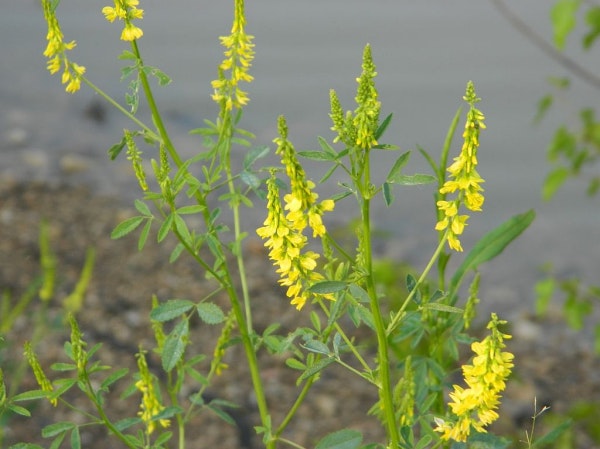Yellow Sweetclover

Yellow sweetclover is the tall plant you see growing throughout the county that has trifoliate leaves (3 leaflets) and racemes of small yellow flowers.
History
According to the book Principles of Field Crop Production, by Martin and Leonard, sweetclover originates from the Mediterranean region and was grown as a crop there over 2,000 years ago. It was brought to the US for green manure, pasture, seed, silage, and hay the over 300 years ago, and now more than 2 million acres of sweetclover is grown annually in the United States.
Why was it introduced?
Sweetclover was introduced and cultivated for its forage and soil quality properties. As a legume, sweetclover is a nitrogen-fixer; the symbiotic relationship it has with bacteria in the soil allows it to fix atmospheric nitrogen into usable nitrogen. Because nitrogen is a fundamental element of amino acids and protein, legumes naturally have high protein content. Furthermore, as an essential nutrient, protein is often used a gauge for forage quality; higher protein content equals higher forage quality. Thus, sweetclover is good forage for most livestock and wildlife. It also acts as a pollinator species and has been known to make delicious honey. Lastly, nitrogen fixers like sweetclover, contribute to the health of the soil in which they are planted by providing soil stability and reducing soil erosion, encouraging soil biotic activity, increasing soil water-holding capacity, and increasing soil aeration. Accordingly, sweetclover has been added to reclamation mixes in the past thanks to these soil health qualities.
Why do we not like it?
Despite, these positive attributes of yellow sweetclover, there are some cons to yellow sweetclover as well.
Yellow sweetclover is an aggressive species that can reproduce in large numbers and is often the first plant to appear on disturbed sites. The plant degrades native grasslands and reduces biodiversity by covering and shading native sun-loving plant species.
Sweetclover is a prolific seeder, producing over 100,000 seeds in a given season, and those seeded remain viable for many years. It is also drought, fire, and cold tolerant.
Because it is quick to establish on clear and disturbed sites and is easy to disburse, yellow sweetclover can often be found along roadways and trails. This presents a danger to motorists because it can grow to 6 feet tall, can decrease visibility, and can obscure wildlife hiding along the roadside.
Sweetclover contains a compound called “coumarin”. When sweetclover gets stressed (i.e. frosted) the coumarin is converted into toxic dicumarol. Dicumarol is an anticoagulant and vitamin K antagonist, thus decreasing the blood’s capability to clot and increasing the potential for hemorrhaging. Keep in mind, fresh sweet clover is not toxic; it is sweetclover that has been subjected to stress or a hard frost that is prone to toxicity.
How do we control it?
Mechanical, prescribed burning, and chemical treatments can all be effective on yellow sweetclover if done properly. As a biennial, it is important to manage plants when they are in their first year and immature. Mature plants have tough stems that may be difficult to mow. Hand pulling can be effective if done when plants are small and the ground is moist. Mowing operations should cut plants very close to the ground.
Chemical - A few herbicides are available for yellow sweetclover control. Imazapyr, picloram, metsulfuron methyl, sulfomethuron methyl, dicamba, clopyralid, and 2,4-D may control the plant.
If you graze livestock, avoid grazing in pastures that have yellow sweetclover after the first good frost due to its toxicity.
Contact Grand County DNR (970.887.0745) or Summit County Weed Control (970.668.4218) for additional weed information and recommendations.
